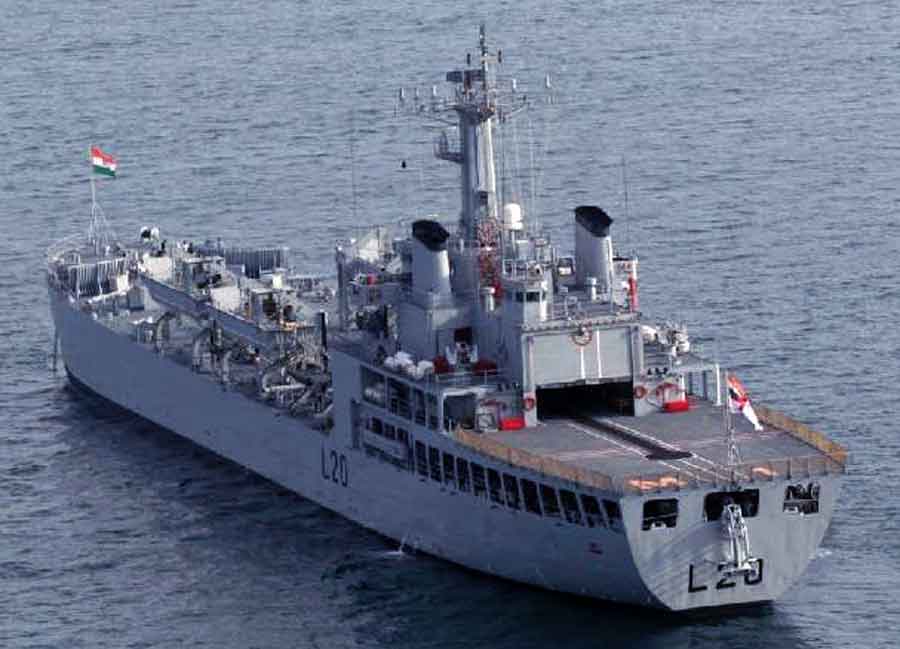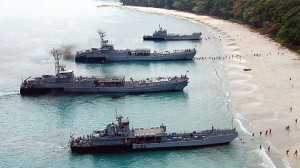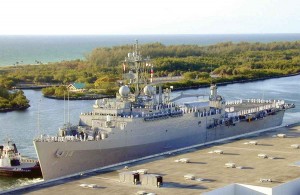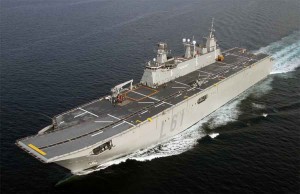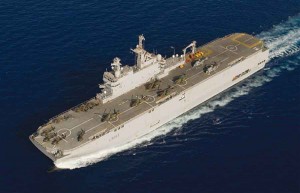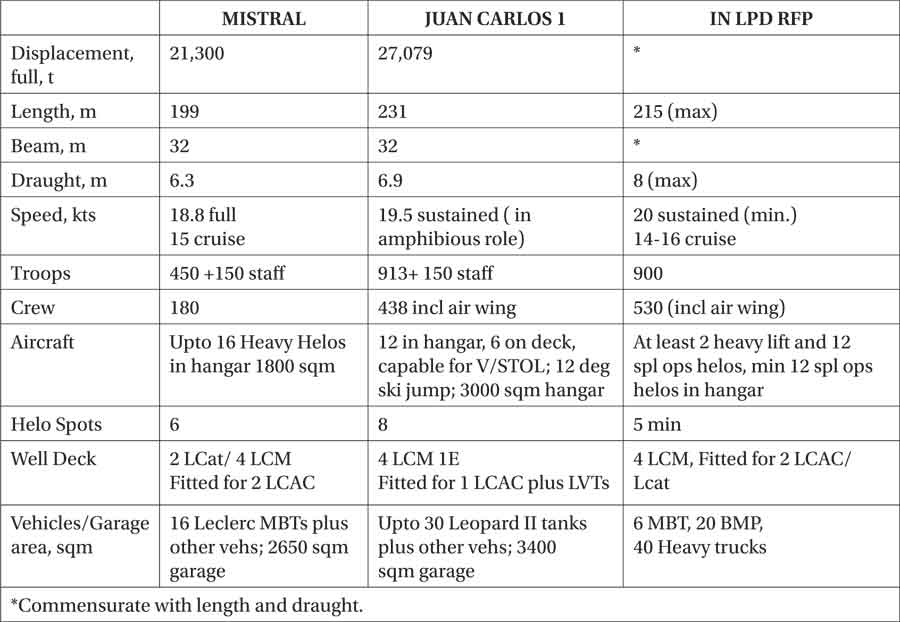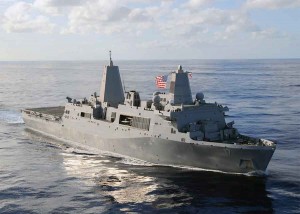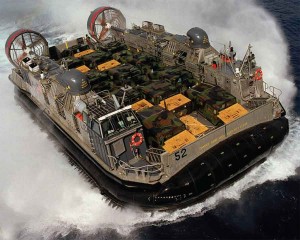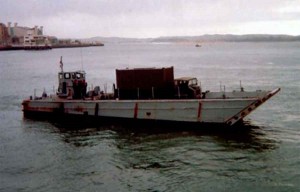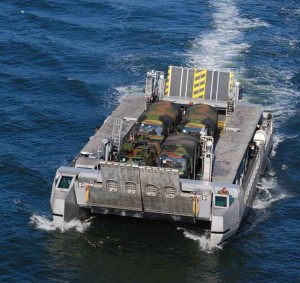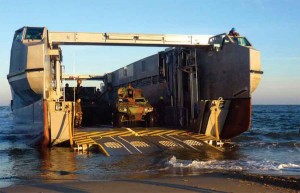Over the last four decades, the main factors influencing amphibious operations have altered, and these have had a bearing on the design of amphibious ships. In particular, the capability of shore-based coastal defence has increased by several magnitudes. Consequently, frontal amphibious assaults against well-defended positions, of the type executed during WW II, would, in all probability, not be contemplated in view of the likelihood of high casualties. Whatever be the objective, certain common conditions would need to be ensured for the success of the operation, and the design of modern amphibious ships has been driven by the need to meet these conditions.
Amphibious operations continue to retain their centrality in military plans…
Amphibious operations have often shaped the destiny of nations down the ages; from the mythological Trojan War to the conflicts among the ancient Mediterranean states, the Viking raids across the North Sea to the campaigns in the Pacific and the Normandy landings of WW II, the Korean war to more recently, the Falkland operations, the outcome of many a conflict has been determined by amphibious operations. During the Cold War, both, NATO and the Warsaw Pact alliances maintained amphibious assets. In the present day, modernisation and expansion of amphibious forces is being taken up by several navies, aimed at expanding and sustaining expeditionary power projection capability, and also for the humanitarian role of disaster relief.
Amphibious operations continue to retain their centrality in military plans and amphibious forces remain a potent and effective means of power projection. The size and lift capacity of amphibious warfare ships built in the post Cold War era , as well as their overall capability has markedly increased. Amphibious forces can be positioned, in advance, in international waters, within easy reach of the envisaged area of operation, and be in a position to execute assigned tasks at short notice. The very existence of amphibious forces constitutes a ‘threat in being’ for the opposition, and even if not committed, do exert a marked constraint on the freedom of action of the latter and their presence could bring about a favourable outcome even before the outbreak of hostilities.
The Indian Navy appreciated the significance of amphibious warfare, and maintained a capability in this field right from its infancy, with an ex-British LST “Magar”. In the 1970s, an indigenously built Landing Ship Tank – (Large) or LST (L) of the same name, displacing 5,400 tonnes, was commissioned, and to-date, five ships of this class including ‘follow-on’ improved versions, have been indigenously built and are in service. Further, from the late 1960s onwards eight smaller Landing Ship Tank – (Medium) or LST (M) of the Polish built “Polnochny” class, the latter batch displacing about 1,150 tonnes, were acquired in two tranches. Of these, the latter four remain in commission, (with their propulsion plants replaced with indigenous machinery). In addition, nine Landing Craft Utility (LCUs) displacing about 500 tonnes were indigenously constructed of which six remain in commission. Eight improved LCUs are presently under construction at an Indian shipyard.
Recognising the need to augment its amphibious capability in the developing geopolitical environment in the Indian Ocean Region, in 2007 the Indian Navy acquired its first Landing Platform Dock (LPD) the INS Jalashwa (ex USS Trenton) and stepped into the big league. Displacing about 16,600 tonnes, with a top speed of about 21 knots, this acquisition resulted in a quantum increase in the Indian Navy’s amphibious capability. In November 2013, the Indian Navy issued an RFP, inviting bids from shortlisted private sector Indian shipyards for construction of two LPDs, in technical collaboration with approved foreign shipbuilders/designers. The RFP also indicates that a further two identical LPDs would be built by the government (Ministry of Defence) owned Hindustan Shipyard Ltd., Visakhapatnam. These ships would provide the Indian Navy a potent power projection capability.
The Indian Navy appreciated the significance of amphibious warfare, and maintained a capability in this field right from its infancy…
Over the last four decades, the main factors influencing amphibious operations have altered, and these have had a bearing on the design of amphibious ships. In particular, the capability of shore-based coastal defence has increased by several magnitudes. Consequently, frontal amphibious assaults against well-defended positions, of the type executed during WW II, would, in all probability, not be contemplated in view of the likelihood of high casualties. Even if an undefended or lightly defended coastal objective is selected, the defenders would be able to redeploy forces from other positions fairly quickly, using modern means of military mobility, to thwart the landing force from achieving its objective. Therefore, the amphibious operation needs to be conducted by ensuring favourable terms of engagement for the landing force. This firstly requires careful defining of the objective. For example, whether the aim is to establish a base for further major land operations in the hinterland or at the other end of the scale whether a ‘raid’ for a limited aim such as destroying specific assets, or rescuing/recovering personnel, or feint to divert the enemy’s attention, is intended. Whatever be the objective, certain common conditions would need to be ensured for the success of the operation, and the design of modern amphibious ships has been driven by the need to meet these conditions.
Firstly, an element of surprise is essential. The force should, therefore, arrive off its objective undetected. A high transit speed is required as it would allow the amphibious force to arrive at its objective from considerable distance, under cover of darkness, thus reducing the probability of it being detected or its destination being ascertained. The main force would normally position itself ‘over the horizon’ from its shore objective, in order to remain unobservable from the shore as long as the situation so requires.
A substantial integral aviation lift capability is a de rigeur design requirement for present day amphibious ships…
Secondly, having arrived at the objective, the land force needs to be rapidly concentrated ashore, at the beachhead or at the inland objective in order to commence its operations straightaway, before the defenders can react. Also, capability to rapidly evacuate/re-embark the land force on completion of the operation, or as required by the tactical situation, is essential. Presently, helicopters provide the most rapid means of disembarkation from the amphibious ship and transit to and from the landing location. They allow troops to be rapidly disembarked at inland objectives, well away from the shoreline, while the ship is stationed ‘over the horizon’. A substantial integral aviation lift capability is a de rigeur design requirement for present day amphibious ships. Depending on the requirements and the budget, the aviation capability could include integral airborne strike and close air support capability, generally by STOVL aircraft. The design of the ship would, therefore, need to provide the full range of operational and maintenance facilities for integral aviation. The latter is weight and volume intensive.
While helicopters provide the most rapid means of disembarkation, they do have payload limitations. The amphibious operation could well require rapid deployment of armour (MBTs, light tanks and APCs) and artillery elements, requiring amphibious ships to be provided with appropriate ‘ship-shore connecters’, (landing craft) which need to combine high payload with high transit speed, rapid loading and unloading capability, as well as good sea-keeping ability, so that the throughput in terms of ‘shuttles per day’ can be maximized. For operation of such craft, amphibious ships require to incorporate a floodable “well dock” in the stern part of the ship. The landing craft are stored in the dock and enter and leave the dock through a “stern gate” located at the transom. Smaller landing craft are also provided, as specified, stowed on davits or in side recesses and these can be launched and recovered with suitable launching /recovery systems, without the need for docking/undocking operations.
In order to be capable of meeting the requirements of the entire spectrum of operations, amphibious warfare ships need to be capable of carrying the full range of equipments and stores that could be required by the embarked force to meet any contingency. The stowage arrangements need to facilitate disembarkation of only those equipments required for a particular operation, without the need for shifting/unloading other equipment, not required for the immediate task. Movement routes, therefore, need to be incorporated in the design of the ships, to facilitate easy and rapid movement of embarked force personnel and their equipment from their living/storage areas to points of disembarkation on the helo/flight deck and well deck. For this, lifts, ramps, ladders and walkways need to be provided, along with handling equipment for stores, such as monorails, gantry cranes and conveyers. Flexibility of utilising aircraft hangars for stowing additional vehicles as required by the situation also needs to be ensured.
Accommodation requirements of the embarked force, air wing and ship’s crew also need to be met. The standard of accommodation needs to be suitable for enabling prolonged occupation, as the ship could be deployed at sea for considerable duration. The space required for accommodation, stores and equipment of the personnel is, therefore, appreciable. In addition, extensive medical facilities analogous to a fully equipped hospital and (joint) C4I facilities to allow the ship to operate as a Command Platform need to be provided.
Accommodation requirements of the embarked force, air wing and ship’s crew also need to be met…
Provision of the above-mentioned capabilities, especially the weight and volume intensive facilities for housing and maintaining the integral aviation wing, have resulted in a marked increase in the size and cost of present day amphibious ships as compared to their slow, flat-bottomed forbears of yesteryear. Although, traditional flat bottomed landing ships are still in commission in a number of navies, they have little utility for intensive amphibious operations envisaged in the present day, due to their low speed and limited aviation capability. However, they remain effective for low intensity amphibious operations and for disaster relief.
Current day amphibious warfare ships are generally of two types, the larger ones, with greater aviation capability are configured with aircraft carrier type flat upper decks, with island superstructures on the starboard side and are normally termed as Landing Ship, Helicopter Dock (LHDs). This allows a greater number of helicopter ‘spots’ to be provided and, depending on the size of the ship, also enables the operation of STOVL fixed-wing aircraft, for which a ‘ski-jump’ could be provided to increase the effectiveness of fixed-wing strike aircraft. The aircraft hanger is normally located on the second deck, below the flight deck. Smaller vessels have a centralised superstructure forward, with a large helo deck aft, with the hangar generally being located forward of the helo deck, at the same level are normally termed as Landing Platform Dock (LPDs). Speed, size and sea keeping requirements mandate a conventional mono-hull design, which would not be required to be capable of directly beaching but would be required to have full capability for rapidly landing the embarked force and its equipment from a stand-off position over the horizon out of visual contact from the shore.
In the Indian Navy’s recently released RFP, though the ship is termed as a LPD, the specification requires a “through” flight deck, with a below deck hangar, akin to what is normally termed as a Landing Ship Helicopter Dock (LHD). It would be instructive to compare the IN’s key requirements, i.e. in respect of size, speed, payload and amphibious assets with those pertaining on contemporary modern LHDs. Comparison will be made with the French “Mistral” class, designed by DCNS, and the Spanish “Juan Carlos 1” designed by Navantia, as in the table (Ref 1-5) above :-
Speed, size and sea keeping requirements mandate a conventional mono-hull design…
The foregoing comparison indicates that the IN’s requirements are, in general, of the same order as those of current proven designs. The technical risk in evolving a successful design meeting the IN’s requirements would, therefore, be minimal. Although the comparison has been restricted to ‘through deck’ ships, the traditional LPD type concept, with a superstructure located forward, large helo deck located aft and a stern well-dock, is an equally valid option for naval planners, depending on their requirements, and continue to be built, the US Navy’s LPD-17 class being a notable example.
While finalising the design of the amphibious warship, the selection of the ‘ship-shore connecter’ is a critical factor. The amphibious force could well arrive at the stand-off point undetected, at the planned time but unless it is capable of delivering the heavy equipment of the embarked amphibious force, from the stand off point to the beach, in the shortest possible time so as to achieve the required concentration of force, success may be elusive. Approaching the beach edge requires traversing shallow water, for which, flat bottomed, rectangular ‘shoe-box’ shaped landing craft, generically termed Landing Craft Mechanised (LCM), equipped with a ramp at the forward end, have been in use since the WW II era. These craft are slow, and do not ride well in a high sea state that can obtain at the stand-off point. Their carrying capacity is limited, and when fully loaded, the draft increases and prevents them from reaching the water’s edge, precluding ‘dryshod landing’ for personnel and vehicles, increasing their vulnerability.
Air cushion vehicles, such as the Landing Craft Air Cushion (US LCAC), built by Textron Marine and Land Systems, overcome the limitations of the landing craft, in terms of speed and they are able to disembark their loads beyond the shoreline.
However, they are several orders of magnitude more expensive than water-borne craft and their operation requires special arrangements, posing limitations:-
- Special ventilation arrangements are required in the well deck to control the temperature rise when LCAC engines (aero gas turbines) are operating.
- Vehicles are required to reverse into the LCAC, in order to drive out ‘forward’.
- Loads need to be carefully balanced as in an aircraft, requiring precise positioning of vehicles.
- The LCAC needs to be inspected for loose/foreign objects prior to starting engines, to prevent FOD, increasing preparation time.
- For carrying a high number of personnel, a special ‘personnel transport module would need to be erected for safety, which is time consuming and reduces flexibility.
- The LCAC would not reverse in its approach track to the beach, but requires space on the beach to turn around.
- Specially trained maintainers (upto ten) need to be embarked, as requisite skills would not be available with the ship’s crew.
Despite its advantages over the traditional LCMs, it is not surprising that besides the US Navy, it is in service only with the Japan Maritime Self Defence Force.
Efforts to develop a ship-shore connecter, which provides performance comparable or better than the LCAC, without the attendant limitations of the latter, and with a substantially lower price tag have resulted in the development of the Landing Catamaran (L-Cat) by the French firm Constructions Industrielles de la Mediterranee (CNIM)). This innovative craft has a ‘variable shape’ hull form.
The catamaran comprises two narrow hulls, housing the propulsion plant, conning positions, tanks and other ship systems. A pontoon type ‘loading platform’ is suspended between the hulls, on hydraulically operated jacks, which can raise and lower the platform. Ramps are fitted at each end of the loading platform, which provide ro-ro capability, enabling vehicles to be loaded as well as disembarked while driving ‘forward’, thereby cutting down on the turnround time. When operating in deep water, the platform is raised, and the catamaran hulls provide a stable ride at high speed due to their low resistance. For beaching and for entering the stern dock of the mother ship, the pontoon is lowered and forced downward, into the water. The buoyancy of the pontoon causes the twin hulls to ‘rise’ out of the water, thereby reducing the draft of the vessel, and enabling the forward ramp to touch down on the dry beach surface.
The unique features of the LCat are:-
- High load carrying capacity, 80 tonnes normal and 100 tonnes maximum vs 54 tonnes of LCM 1E and 60 tonnes of the LCAC
- High speed 30 knots light and 18 knots loaded vs 22 knots light and 13 knots loaded of LCM 1E.
- High maneuverability can turn on its axis at low speed and can ‘slide’ laterally.
- High power of four water jets enable craft to pull away from the beach without using the kedge anchor, and enable it to maintain position on the beach in cross wind conditions.
- Capability of landing at waters edge on beaches gradient as low as two per cent.
- Capable of loading/unloading vehicles by deploying own ramp on the well deck sill of the mother ship without having to enter the dock dramatically reducing turnround time between shuttle trips.
- Low cost (both, initial and through life) as compared to the LCAC, with a higher ‘per day’ throughput rate.
The French Navy has commissioned four LCats, which have been given the nomenclature “EDAR”, and has an option for four additional craft. Other potential buyers have also shown interest. Other than being unable to traverse across land, its performance surpasses that of the LCAC and conventional LCMs, especially for stand off beaching operations, due to its high payload, high speed and lower turn-round time. It can operate from any suitably sized well dock, without any special arrangements having to be made. For operating the LCAC, the mother ship needs to have special ventilation arrangements in the well deck to control the rise in temperature caused by the running of the LCAC’s engines. The L-Cat therefore allows navies to complement their modern and capable amphibious warfare ships with an extremely efficient and effective ship-shore connecter, greatly enhancing their amphibious capability. It is relevant that the RFP issued by the Indian Navy, requires the well dock to be capable of accommodating two LCats.
The LCAC 100 is expected to have improved payload, speed, fuel efficiency and reliability…
Looking into the foreseeable future, amphibious operations would continue to remain a valid option for military planners, because the oceans connect the world and allow the deployment of amphibious forces in locations of ones choosing, with the ability to project power into the hinterland as demanded by the situation. They are often the only option for providing succour in times of natural disasters. Technological advances can be expected in both, amphibious ships and their ship-shore connecters.
A greater stress on increasing the integral aviation capability could be expected, by way of increased number of embarked helicopters as well as capability to operate tilt rotor craft. Depending on the affordability and availability of STOVL aircraft, incorporation of ski jumps on flight decks could more frequently specified. Stealth features would be incorporated into designs to a greater extent, as seen on the LPD-17 class. Development of ship-shore connecters is expected to continue apace. The LCAC 100 is expected to have improved payload, speed, fuel efficiency and reliability and there are indications that it would be supplied to the US Navy around 2019. However, its cost would probably be a deterrent to non-US users. Developments of the L-Cat, including a larger version for autonomous operation, independent of the mother ship, are also in the offing. These and other developments would continue to engage the attention of naval planners over the world.
References
- “Shape of Things to Come: Spain’s New Projection Ship Readies For Sea”, Nick Brown Jane’s IDR, Oct 2009 pp 70 -75
- “Amphibious Assault and Power Projection Platforms”, Massimo Annati, Military Technology, 11/2007, pp 64 – 73
- “France’s Amphibious Renaissance Adds Weight to Naval Power Projection”, Richard Scott, Jane’s IDR, Dec 2011, pp 52 – 56
- “Shipping New Challenges”, ER Hooton, Armada International, 5/2005, pp 19-24
- http://www.defensenews.com/article/20131212/DEFREG03/31212003
- http://wikipedia.org/wiki/Landing_Craft_Air_Cushion
- Data on LCat, courtesy CNIM.




